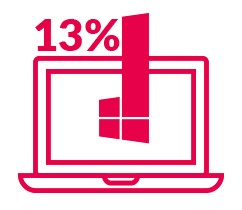Anti-Virus
Anti-virus software is one of the most commonly used cybersecurity tools for endpoint protection.
- Published
- September 01, 2021
 Despite the increased awareness and implementation of anti-virus solutions, the ENISA Threat Landscape Report 2020 shows that there was a 13% increase since 2019 in Windows malware detections at business endpoints globally and that 71% of organizations experienced malware activity that spread from one employee’s computer to another. The report also highlighted that malware attacks have grown in volume and in sophistication.
Despite the increased awareness and implementation of anti-virus solutions, the ENISA Threat Landscape Report 2020 shows that there was a 13% increase since 2019 in Windows malware detections at business endpoints globally and that 71% of organizations experienced malware activity that spread from one employee’s computer to another. The report also highlighted that malware attacks have grown in volume and in sophistication.
It protects against various kinds of malware, unauthorized malicious software designed to cause harm. Malware can gain access to important information such as bank credentials, credit card numbers or passwords. It can also take control or spy on a user’s computer.
The majority (88%) of the survey participants already implemented some form of anti-virus solution even before the COVID19 pandemic, and the number appears to have further risen (>90%) during the COVID19 pandemic.
An anti-virus solution should be implemented on all types of devices and kept up-to-date in order to ensure its continuous effectiveness. This includes employees’ tablets and smartphones connected to the company network, be it in SME’s or their ownership. This anti-virus solution should provide the SME with the ability to centrally manage the anti-virus software installed on all devices within the organization and ensure that it is kept up to date. Should the anti-virus software on any of the devices detect a potential infection it should also alert the appropriate personnel within the SME to deal with the situation.